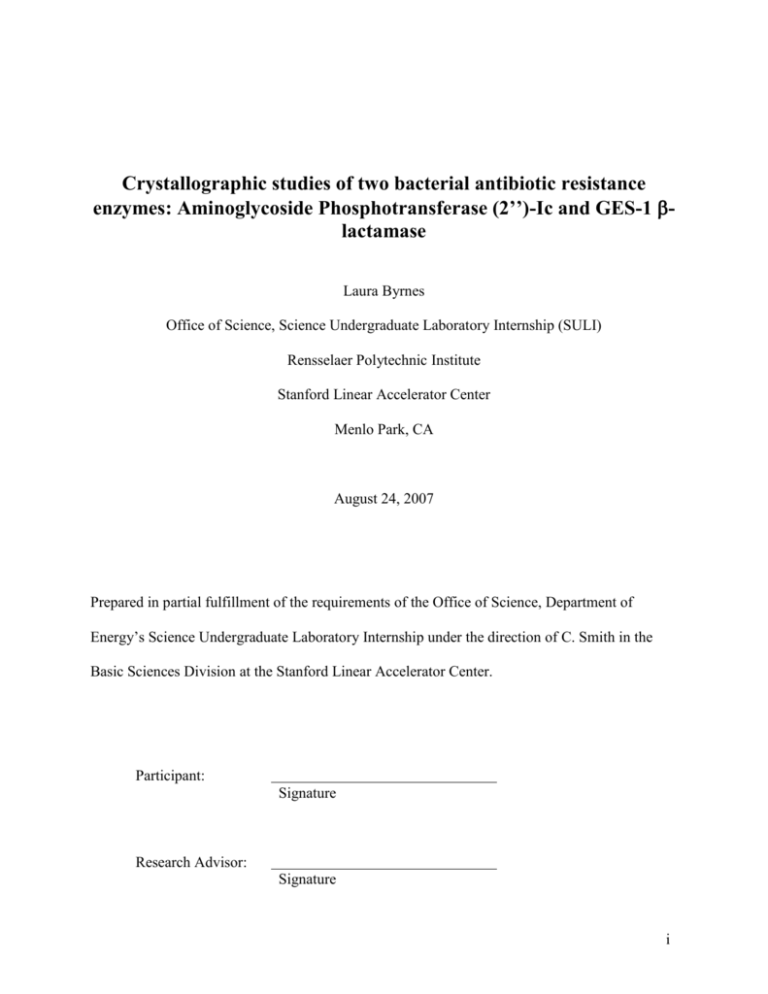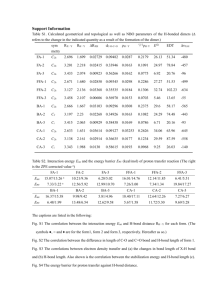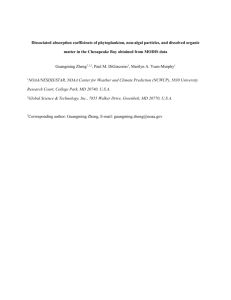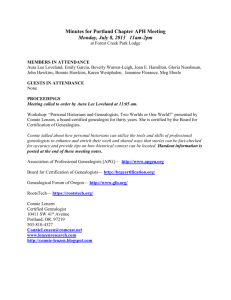report - Macromolecular Crystallography
advertisement

Crystallographic studies of two bacterial antibiotic resistance enzymes: Aminoglycoside Phosphotransferase (2’’)-Ic and GES-1 lactamase Laura Byrnes Office of Science, Science Undergraduate Laboratory Internship (SULI) Rensselaer Polytechnic Institute Stanford Linear Accelerator Center Menlo Park, CA August 24, 2007 Prepared in partial fulfillment of the requirements of the Office of Science, Department of Energy’s Science Undergraduate Laboratory Internship under the direction of C. Smith in the Basic Sciences Division at the Stanford Linear Accelerator Center. Participant: Signature Research Advisor: Signature i Table of Contents Abstract iii Introduction 1 Materials and Methods 3 Results 5 Discussion and Conclusion 6 Acknowledgements 7 References 8 Tables 10 Figures 10 ii ABSTRACT Crystallographic studies of two bacterial antibiotic resistance enzymes: Aminoglycoside Phosphotransferase (2’’)-Ic and GES-1 -lactamase. LAURA BYRNES (Rensselaer Polytechnic Institute, Troy, NY 12180) CLYDE SMITH (Stanford Linear Accelerator Center, Menlo Park, CA 94025) Guiana Extended-Spectrum-1 (GES-1) and Aminoglycoside phosphotransferase (2’’)-Ic (APH(2’’)-Ic) are two bacteria-produced enzymes that essentially perform the same task: they provide resistance to an array of antibiotics. Both enzymes are part of a growing resistance problem in the medical world. In order to overcome the ever-growing arsenal of antibioticresistance enzymes, it is necessary to understand the molecular basis of their action. Accurate structures of these proteins have become an invaluable tool to do this. Using protein crystallography techniques and X-ray diffraction, the protein structure of GES-1 bound to imipenem (an inhibitor) has been solved. Also, APH(2’’)-Ic has been successfully crystallized, but its structure was unable to be solved using molecular replacement using APH(2’’)-Ib as a search model. The structure of GES-1, with bound imipenem was solved to a resolution of 1.89Å, and though the inhibitor is bound with only moderate occupancy, the structure shows crucial interactions inside the active site that render the enzyme unable to complete the hydrolysis of the -lactam ring. The APH(2’’)-Ic dataset could not be matched to the model, APH(2’’)-Ib, with which it shares 25% sequence identity. The structural information gained from GES-1, and future studies using isomorphous replacement to solve the APH(2’’)-Ic structure can aid directly to the creation of novel drugs to combat both of these classes of resistance enzymes. iii Introduction For almost as long as bacteria have existed, they have waged wars against each other using an arsenal of chemicals which attack specific cellular processes necessary for their survival. In turn, it was necessary to have some way of preventing these chemicals from harming their maker, as well as have a defense against the antibiotics produced by other bacteria. In this way, antibiotic resistance was born and has advanced (with help from humans) to where it is today. Two such resistance proteins are the subject of this study. Protein crystallographic analysis is used to understand these types of proteins’ enzymatic mechanisms, with the ultimate goal of creating novel drugs which will either deactivate these enzymes or bypass their action completely. The general class of -lactamases has been a part of antibiotic resistance since the beginning of the wide-spread use of antibiotics. The more recent arrival of extended-spectrum lactamases (ESBLs) has added to this problem. One of the most recent families of ESBLs to be discovered is the Guiana Extended-Spectrum (GES) family [1]. The protein sequence of the GES proteins has significant differences from other -lactamases of the same class [2]. The classification of “extended-spectrum” resistant -lactamases refers to the fact that they are able to hydrolyze (deactivate) the type of -lactam antibiotics designed to resist hydrolysis by lactamases identified previously, often referred to as “last resort” antibiotics. The -lactam family of antibiotics, which include the penicillins, cephalosporins, carbapenems, and monobactams, act by disabling cell-wall biosynthesis proteins, namely transpeptidases, which are responsible for the construction and modification of a peptidoglycan layer surrounding the cell membrane [3]. The way in which -lactamases affect the action of these types of antibiotics is by hydrolyzing the -lactam ring structure. Within the -lactamase family, there are four 1 classes: A, B, C, and D [4]. The GES family is a class A -lactamase, and is further classified as a third generation carbapenemase. The general structure of carbapenems is shown in Figure 1. The protein of interest in this study, GES-1, shows strong activity against most carbapenems, with some exceptions such as imipenem (structure shown in Figure 1) and specific inhibitors clavulanic acid, tazobactam, and sulfobactam [2]. The interesting part about its resistance profile is that while it is inhibited by imipenem, two other point mutants, namely GES-2 and GES-5, show 100-fold and 400-fold increases respectively in hydrolysis of imipenem [5]. The results of this structural study will aim to answer the question as to why these point mutants show such drastic differences in their activity towards imipenem. Aminoglycosides are a second type of antibiotic used in medicine today. This class of antibiotics inhibits bacterial growth by binding to ribosome active sites, thereby halting protein synthesis [6]. With this second type of antibiotic comes a separate class of resistance enzymes. In general, they are called transferases, as they catalyze the transfer of a specific functional group to the antibiotic, thereby deactivating it. Aminoglycoside phosphotransferases (APH) are one member of this family of enzymes. APH enzymes transfer a phosphate to a particular hydroxyl group of the aminoglycoside antibiotic in an ATP-mediated fashion [7]. There are many isoforms of APH proteins, each classified by which hydroxyl group they phosphorylate (identified by a number in parenthesis), and the type of antibiotics they show activity against. For example, the enzyme in this study, APH(2’’)-Ic, phosphorylates the 2’’ hydroxyl of gentamicin, kanamycin, and tobramycin (see Figure 2 for some example structures). Of the APH enzymes, three others have had their crystal structures solved, including APH(2’’)-Ib, APH(3’)-IIa and APH(3’)-III [6, 8]. Several variants were used to attempt to grow crystals for this protein, including the wild-type and several mutants (two single and one double), with and without nucleotide (GTP) bound. By 2 working out the conditions for crystallizing APH(2’’)-Ic, though the structure was unable to be solved with molecular models, this study will aid in speeding up the process for future studies using alternative techniques (e.g. isomorphous replacement) for solving its structure. Materials and Methods Protein crystallization For all of the APH(2’’)-Ic variants, initial coarse screens were performed using commercially available sparse-matrix screens (Crystal Screens I and II, Hampton Research) using the sitting drop method. One condition from Crystal Screen I [30% PEG 4000, 0.1M Tris HCl pH 8.5, at 15°C] resulted in crystals for F108L, wild-type, and double mutant variants (all bound GTP). Further fine screening of the F108L mutant using the hanging drop method resulted in crystals suitable for diffraction. Crystals grew as clusters of thin plates in 2μL drops containing protein in 25mM HEPES buffer (pH 7.6), 1mM DTT, and 1mM Mg2GTP, at a protein concentration of 8.8 mg/ml. The drops with the three crystals used for data analysis contained a 1:1 mixture of protein to solution, one in 20% and two in 23% PEG 4000, all with 0.25M MgCl2, and 0.1M Tris HCl (pH 8.5), with the first (20% PEG) grown at 15°C and the other two (23% PEG) grown at 22°C for 3 days before harvesting. In addition, later fine screening using the wild-type protein produced similar crystals (flat and clustered), in conditions which included 2325% PEG 4000, 0.2M MgCl2, 0.1M Tris HCl (pH 8.5), at 22°C. Data collection and processing The data previously collected for the imipenem-bound GES-1 protein was processed 3 using MOSFLM [9], and merged and scaled with SCALA [10] from the CCP4 suite of programs [11]. Data collection statistics can be found in Table 1. Data from the APH(2’’)-Ic crystals were collected at BL11-1 at the Stanford Synchrotron Radiation Laboratory (SSRL). The crystals used were flash frozen in liquid nitrogen before data collection. Earlier data analysis showed the crystals belonged to the monoclinic C2 space group, with unit cell parameters a = 81.77Å, b = 54.28Å, c = 77.42Å, and β = 108.97°. The calculated Matthews coefficient was 2.38Å/Da, indicating one molecule in the asymmetric unit. Additional data collection statistics can be found in Table 1. Molecular replacement and refinement Molecular replacement of GES-1 (bound imipenem) was carried out using COOT [12], utilizing the previously solved GES-1 structure [5] as the starting model. Refinements were done using the program REFMAC [13], as part of the CCP4 software, using data between 20- and 1.89-Ǻ. A random five percent of the data set was left out as a test set (for the calculation of Rfree). After 10 rounds of refinements, the R-factor and Rfree converged to 15.8 and 21.9% respectively. Molecular replacement of APH(2’’)-Ic was carried out using the program MOLREP [14], using the previously solved structure of APH(2’’)-Ib as a search model. The two proteins share about 25% sequence identity, and the model was modified so as to replace the unconserved residues with alanine. The CCP4 software was used for all calculations. 4 Results: Structural Determination of APH(2’’)-1c Starting from the initial screenings, several of the APH(2’’)-Ic variants exhibited fastformed, spiky crystal formation early on in a solution containing 30% PEG 4000, 0.2M MgCl2, and 0.1M Tris HCl (pH 8.5) at 15°C from Crystal Screen I. Initial tests provided proof that the crystals were indeed protein, and thereafter fine screening to refine crystal formation began. Numerous conditions were tested to slow down crystal formation, and the best results arose from the lower PEG concentrations, the same pH, and similar or slightly higher salt concentrations. Tests on temperature as a factor gave mixed results, with 4°C giving no useful crystals, 15°C resulting in the several useful crystals, and 22°C giving fewer, but better formed crystals. Large crystals formed as several flat sheets stuck together at a point, and when mounting these crystals, the sheets separated fairly easily and could be mounted individually. Useful datasets were collected from three crystals, one with 20% PEG 4000 (grown at 15°C) and two with 23% PEG 4000 (grown at 22°C), all with 0.1M Tris HCl (pH8.5) and 0.25M MgCl2. So far there is no indication as to which, if any, dataset will yield the best results in finding the structure. The APH(2’’)-Ic crystals, namely the F108L mutant, belongs to the space group C2, with one molecule in the asymmetric unit. Efforts to solve the three-dimensional structure using APH(2’’)-Ib have so far failed to give a reasonable solution to the structure. Using the wild-type APH(2’’)-Ic, fine screening of the crystallization conditions resulted in crystals comparable in quality to those used to collect datasets from in the mutant. These conditions included 23, 24, and 25% PEG 4000, 0.2M MgCl2, and 0.1M Tris HCl (pH 8.5), at 22°C. Datasets have not yet been taken from these crystals, as the synchrotron was not in service. 5 Inhibitor-binding studies with GES-1 -lactamase The data was fit using the previously solved GES-1 structure. Some refinement statistics are given in Table 2. The active site residues that are proposed to interact with the inhibitor are present, including Ser64, Lys67, Glu98, and Glu161. The imipenem molecule showed moderate (~65%) occupancy for the active site, with the other fraction occupied by a sulfate group (a solvent molecule). Several features are still visible, including covalent bonding between Ser64 side chain oxygen and the imipenem C7 atom, with a bond length of 1.40Å. The hydrolytic water molecule is also present, but only at lower occupancy (<40%) and forms a hydrogen bonding interaction with oxygen 62 of imipenem and Glu161. Discussion and Conclusion: The solved structure of GES-1 with bound imipenem sheds some light on the reason for the differences in activity between GES-1 and the other GES proteins discovered later. GES-1, although showing the characteristic active site disulfide bond of the carbapenemase-hydrolyzing -lactamases, is incapable of hydrolyzing imipenem, a typical carbapenem antibiotic, and is in fact inhibited by this molecule. It has been shown that two point mutants of GES-1, Gly165Asn (called GES-2) and Gly165Ser (GES-5) [15, 16] have significant activity against imipenem. Although the imipenem molecule was bound with only ~65% occupancy, several interactions between the inhibitor and the active site residues were present. In the refined structure, covalent bonding between imipenem and Ser64 of GES-1 is clearly observed, giving rise to an acylenzyme intermediate which is the first step in the hydrolysis of the β-lactam ring. In addition, there are several hydrogen bonding interactions with other active site residues. A few of these hydrogen bonding partners are shown in Figure 3. Additionally, the hydrolytic water molecule is 6 present in the active site, and has hydrogen bonding partners which include the imipenem and the side chains of Ser64 and Glu161. However, the hydrolytic water molecule, which plays a crucial role in completing the hydrolysis of the β-lactam ring, shows less than 40% occupancy for its site above the hydroxyethyl moiety of the imipenem molecule. This result suggests that the reason for the decrease in GES-1 catalytic activity against imipenem could be due to the fact that the essential hydrolytic water is not held tightly and is therefore not optimally positioned for attack on the acyl-enzyme intermediate. On the other hand, GES-2 and GES-5, having the point mutations G165N and G165S, respectively, provide an additional hydrogen bonding partner for the hydrolytic water. In these enzymes, the hydrolytic water molecule may be held in the correct position to facilitate hydrolysis of the acyl-enzyme. Future structural studies using GES-2 and GES-5 bound imipenem are necessary to provide further evidence for this explanation. The APH(2’’)-Ib model has so far proved to be an insufficient search model for molecular replacement against the APH(2’’)-1c dataset. In the APH(2’’)-Ib structure, the alpha domain is somewhat disordered, which suggests that the APH(2’’)-Ic alpha domain could also be disordered or have a different orientation. Perhaps because of this, the model could not yield a reasonable fit to the data. Further studies using protein bound with 8-bromo-ATP, multiple isomorphous replacement experiments, or the preparation and crystallization of selenomethionine-substituted wild-type APH(2’’)-Ic may provide ways around this problem. Acknowledgements: This research was conducted at the Stanford Linear Accelerator Center. I would like to express my gratitude to my mentor, Clyde Smith, for sharing his expertise, patience, and attention during my short time here. Thank you also to the U.S. Department of Energy for the 7 unique opportunity of participating in the SULI program, one of the most useful learning experiences I’ve ever been privileged to take part in. Finally, I’d like to acknowledge and thank Apurva Mehta, who took time out of his busy work schedule to meet with a group of other SSRL summer students and me to help us gain a deeper understanding of the research we participated in. References: [1] G. F. Weldhagen, “GES: an Emerging Family of Extended Spectrum Beta-Lactamases”, Clinical Microbiology Newsletter, Vol. 28, No. 19, 145-149, Oct. 2006 [2] L. Poirel, I. Le Thomas, T. Naas, A. Karim, and P. Nordmann, “Biochemical Sequence Analysis of GES-1, a Novel Class A Extended-Spectrum β-Lactamase, and the Class 1 Integron In52 from Klebsiella pneumoniae”, in Antimicrobial Agents and Chemotherapy, Vol 44, No. 3, pp. 622-632, Mar. 2000 [3] P. A. Bradford, “Extended-Spectrum β-Lactamases in the 21st Century: Characterization, Epidemiology, and Detection of this Important Resistance Threat”, Clinical Microbiology Reviews, Vol. 14, No. 4, pp 933-951, 2001 [4] W. Sougakoff, G. L’Hermite, L. Pernot, T. Naas, V. Guillet, P. Nordmann, V. Jarlier, and J. Delettre, “Structure of the imipenem-hydrolyzing class A β -lactamase SME-1 from Serratia marcescens”, Acta Crystallographica D, Vol. 58, Part 2, pp. 267-274 [5] C. A. Smith, M. Caccamo, K. A. Kantardjieff, and S. Vakulenko, “Structure of GES-1 at atomic resolution: insights into the evolution of carbapenemase activity in the class A extended-spectrum β-lactamases”, Acta Crystallographica D, Vol. 63, Part 9, pp 982-992, 2007 [6] D. Nurizzo, S. C. Shewry, M. H. Perlin, S.A. Brown, J. N. Dholakia, R. L. Fuchs, T. Deva, E. N. Baker, and C. A. Smith, “The Crystal Structure of Aminoglycoside-3’Phospho-transferase-IIa, and Enzyme Responsible for Antibiotic Resistance”, Journal of Molecular Biology, Vol. 327, pp 491-506, Jan. 2003 [7] C. A. Smith and E. N. Baker, “Aminoglycoside Antibiotic Resistance by Enzymatic Deactivation”, Current Drug Targets – Infectious Disorders, Vol. 2, pp 143-160, 2002 [8] W. C. Hon, G. A. McKay, P. R. Thompson, R. M. Sweet, D. S. C. Yang, G. D. Wright, and A. M. Berghuis, “Structure of an enzyme required for aminoglycoside antibiotic resistance reveals homology to eukaryotic protein kinases”, Cell Vol. 89, pp 887-895. 8 [9] Leslie, A.G.W., “Recent changes to the MOSFLM package for processing film and image plate data “, Joint CCP4 + ESF-EAMCB Newsletter on Protein Crystallography, No. 26, 1992 [10] P.R. Evans, “Scala”, Joint CCP4 and ESF-EACBM Newsletter 33, pp 22-24, 1997 [11] Collaborative Computational Project, "The CCP4 Suite: Programs for Protein Crystallography", Acta Crystallographica D, Vol. 50, Part 4, pp 760-763, 1994 [12] P. Emsley and K. Cowtan, “Coot: Model-Building Tools for Molecular Graphics”, Acta Crystallographica D - Biological Crystallography, Vol. 60, pp 2126-2132, 2004 [13] G. N. Murshudov, A. A. Vagin, and E.J. Dodson, “Refinement of Macromolecular Structures by the Maximum-Likelihood Method”, Acta Crystallographica D, Vol. 53, Part 3, pp 240-255, 1997 [14] A.Vagin, A.Teplyakov, “MOLREP: an automated program for molecular replacement” J. Appl. Cryst., 30, 1022-1025, 1997 [15] L. Poirel, G. F. Weldhagen, T. Naas, C. De Champs, M. G. Dove, P. Nordmann, “GES-2, a Class A β-Lactamase from Pseudomonas aeruginosa with Increased Hydrolysis of Imipenem”, Antimicrobial Agents and Chemotherapy, Vol. 45, No. 9 pp 2598-2603, Sept. 2001 [16] I. K. Bae, Y. N. Lee, S. H. Jeong, S. G. Hong, J. H. Lee, S. H. Lee, H. J. Kim, H. Youn, “Genetic and biochemical characterization of GES-5, an extended-spectrum class A βlactamase from Klebsiella pneumoniae”, Diagnostic Microbiology and Infectious Disease, Vol. 58, Issue 4, pp 465-468, Aug. 2007 9 Tables and Figures: Table 1: Data Collection Statistics for imipenem-GES-1 and APH(2”)-Ic Imipenem-GES-1 APH(2”)-Ic P21 C2 a=42.796, b=81.192, a=82.4 , b=54.2, c=71.892, β=102.18° c=77.0, β=108.8° Resolution (Å) 20-1.89 2.15 Unique reflections 38, 545 14, 484 Total reflections 872,781 377, 107 Rmerge (%) 10.8 9.4 Completeness (%) 99.96 97.1 5.1 6.4 Space group Unit cell parameters (Å) I/σI (%) Table 2: Refinement Statistics for imipenem-GES-1 Resolution range (Å) 20.0 – 1.89 Number of protein residues 266 Number of waters 547 Average B value: 15.837 R-factor/Rfree (%) 15.8 / 21.9 rmsd bond lengths (Å) 0.015 rmsd angles (°) 1.614 General structure Imipenem Figure 1: Chemical structures of carbapenems. 10 Gentamicin Kanamycin Figure 2: Chemical structures of some aminoglycosides. Figure 3: Electron density map of GES-1 active site, bound imipenem. Active site residues and water molecules are shown with blue electron density, while the inhibitor (imipenem) has its electron density shown in pink. 2Fo-Fc density maps are shown. 11







